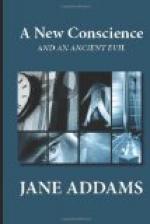Those of us who think we discern the beginnings of a new conscience in regard to this twin of slavery, as old and outrageous as slavery itself and even more persistent, find a possible analogy between certain civic, philanthropic and educational efforts directed against the very existence of this social evil and similar organized efforts which preceded the overthrow of slavery in America. Thus, long before slavery was finally declared illegal, there were international regulations of its traffic, state and federal legislation concerning its extension, and many extra legal attempts to control its abuses; quite as we have the international regulations concerning the white slave traffic, the state and interstate legislation for its repression, and an extra legal power in connection with it so universally given to the municipal police that the possession of this power has become one of the great sources of corruption in every American city.
Before society was ready to proceed against the institution of slavery as such, groups of men and women by means of the underground railroad cherished and educated individual slaves; it is scarcely necessary to point out the similarity to the rescue homes and preventive associations which every great city contains.
It is always easy to overwork an analogy, and yet the economist who for years insisted that slave labor continually and arbitrarily limited the wages of free labor and was therefore a detriment to national wealth was a forerunner of the economist of to-day who points out the economic basis of the social evil, the connection between low wages and despair, between over-fatigue and the demand for reckless pleasure.
Before the American nation agreed to regard slavery as unjustifiable from the standpoint of public morality, an army of reformers, lecturers, and writers set forth its enormity in a never-ceasing flow of invective, of appeal, and of portrayal concerning the human cruelty to which the system lent itself. We can discern the scouts and outposts of a similar army advancing against this existing evil: the physicians and sanitarians who are committed to the task of ridding the race from contagious diseases, the teachers and lecturers who are appealing to the higher morality of thousands of young people; the growing literature, not only biological and didactic, but of a popular type more closely approaching “Uncle Tom’s Cabin.”




